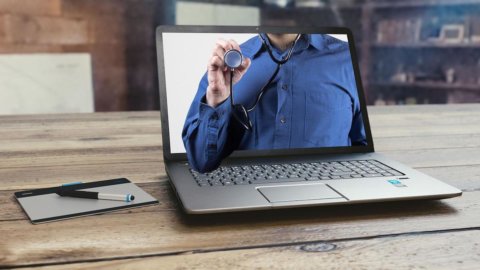Two billion and 800 million euros. This is the amount allocated by the Pnrr (National Recovery and Resilience Plan) for the digitization of the Italian health system. The objectives set by the Plan for 2025 include: 200 patients assisted with telemedicine, 85% of general practitioners who will feed the electronic health record and the digitization of 280 hospitals.
In general, the digital healthcare makes it possible to provide better and more punctual assistance to patients, even remotely, as underlined in Rome during the second edition of theHealth&BioTech summit, the conference promoted by Msd, Deloitte and Intesa Sanpaolo Rbm Salute.
Telemedicine: What are the benefits of digitization?
Reduction of waiting lists, inequalities in access to services, hospitalizations, better adherence to therapies and anti-cancer screenings and optimization of costs. The Electronic Health Record, the pillar of digital healthcare, is the tool with which citizens can trace and consult the entire history of their healthcare life, sharing it in a secure manner with healthcare professionals.
However, as the undersecretary of health pointed out Andrea Costa, who spoke at the event held on Wednesday 27 July in Rome, if on the one hand the Pnrr offers an extraordinary possibility of innovation, on the other: "resources alone are not enough, a new way of conceiving the ecosystem is digital and to do this you need to be able to count on a system that allows data interoperability without which it will not be possible to obtain the results we hope for”.
In such a context, the Health&BioTech summit assumes even more importance since, by promoting the debate on the value of digital transformation of healthcare between institutional representatives, from the academic-scientific world and from companies, it fuels cooperation between the public and private sectors.
The Health&BioTech Accelerator program
Because of this common effort, the second edition of the Health&BioTech Accelerator program should also be read, included in the Health&BioTech summit, which yesterday awarded the 6 most innovative startups among the 1000 who participated, coming from more than 40 countries. The project was coordinated by Deloitte Officine Innovazione in collaboration with various technical-scientific partners, including the major partners Msd Italia and Intesa Sanpaolo Rbm Salute.
“The Health&BioTech Accelerator is an Italian excellence that shows how the Open Innovation paradigm is the winning one: only with a close synergy between all the innovation players can we accelerate and keep pace on the great frontiers of transformation that are involving more and more industrial sectors, including health and biotechnology, priority sectors for our country”, he comments Francesco Iervolino, Partner Deloitte Officine Innovazione and Life Sciences & Health Care Innovation Leader Deloitte Central Mediterranean.
He also spoke during yesterday's summit Maximus Weaver, CEO and General Manager of InSalute Servizi, a new company of the Insurance Division of Intesa Sanpaolo (65% owned by Intesa Sanpaolo Vita and 35% by Blue Assistance, which belongs to Reale Group), and declared: "digital and technological progress can have a fundamental impact on the innovation of the entire people management system and their needs and care pathways, and with the aim of further developing the digital products and services of Intesa Sanpaolo Rbm Salute, InSalute Servizi was born, with which we want to help give a further boost to this ongoing transformation, evolving the offer and the methods of partnership with affiliated structures".
Telemedicine: before and after the pandemic
In the pre-pandemic phase, digital healthcare was still in its infancy. According to a survey conducted by theHigher Institute of Health, between 2014 and 2017 around 350 sporadic experiences of telemedicine were ascertained and that only one citizen out of ten used the electronic health record. Two years later, in 2019, the Ministry of Health launched a research on the experiences, at the regional level, of telemedicine. The mapping showed that 2018 projects were active in 282, with a rather heterogeneous distribution among the regions.
As you can easily guess, during the pandemic telemedicine initiatives have increased exponentially, stimulated above all by the private sector, which therefore has not limited itself only to the global diffusion of drugs e vaccines against Covid-19.
“Since March 2020, pharmaceutical companies – he recalls Nicoletta Luppi, President and Chief Executive Officer of Msd Italia – have activated as many as 247 telemedicine initiatives which have brought important benefits to people suffering from chronic pathologies who have been able to continue following their treatment paths without leaving their homes. During the pandemic, algorithms were perfected in various Italian regions capable of promoting patient adherence to therapies and which allowed doctors to check and monitor the state of health of patients in real time. Msd - Nicoletta Luppi again assures - intends to continue to support these projects in order to overcome, thanks to digital technologies, the difficulties that the pandemic has caused to assistance in the presence of patients, thus favoring an 'accelerated' recovery also of the good health".
For its part, the Italian state has been engaged in the digital transformation of healthcare for some time. In the last 8 years, in fact, more than have been approved 10 national measures on digital health, of which the latest (DL 27 January 2022, n.4) defines the role ofAGENAS (National agency for regional health services). Based on the decree law, the national telemedicine platform will be managed by AGENAS, with the aim of promoting the local adoption of telemedicine solutions according to models applicable on a large scale. On the other hand, the national strategy within the Pnrr is precisely this: to ensure that a national telemedicine platform can be the starting point for new projects and solutions within regional systems.





